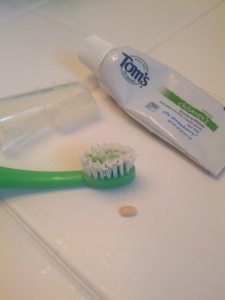This post has been sponsored by our partner Richardson Dentistry to bring you the latest health information on your child’s dental care.
Fluoride Toothpaste Should Now Be Used On Baby Teeth
I love my boys to death, but for me there’s been nothing worse than trying to convince my (almost) 4 year old and 2 year old to brush their teeth.
In the beginning when teeth first started to make their appearance, my first son went through the typical phase where full out tantrums ensued at the sight of a toothbrush. My husband or I (sometimes both) would unsuccessfully try to bribe my son to open his mouth and then we’d usually give up and just resort to prying which sometimes resulted in a bit or two. Then when he became old enough to brush his own teeth, he wanted to be responsible for putting his own toothpaste on…which would cause MORE tantrums because we wouldn’t allow him to just suck off the toothpaste.
Thankfully we’re finally now at an age where we’ve been able to put away the restraints (aka our arms) and no longer need to have excessive lectures about why we can’t lick the toothpaste each morning and night. For the most part, he jumps up onto his step stool, brushes his teeth with a small amount of fluoride toothpaste, rinses and spits.
With my second (who’s now almost 2), he watches everything his older brother does and wants to do the same thing–except he’s 2 years younger. The teeth brushing battle has started all over again for us, only now at a younger age. Not only does he refuse to allow us to brush his teeth (because he can clearly do it himself!?) but he doesn’t understand why he isn’t allowed to have the same Disney Cars toothpaste that my older son has.
The Old Recommendation on Fluoride
For decades, the American Dental Association highly recommended avoiding fluoride for children ages 2 and younger to minimize the risk of fluorosis. Dental Fluorosis is a condition caused by ingesting too much fluoride.
Children who have fluorosis will have white streaks or speaks on their teeth to more serious forms of brown discoloration or markings. These stains are permanent and may darken over time. Even though (at this level) it’s not serious to your physical health, treatments to hide or remove these stains can be costly.
The New Recommendation on Fluoride
While the old recommendation isn’t inaccurate in trying to protect your children from fluorosis, the ADA is now finding that 25% of American children are now developing cavities and/or tooth decay before Kindergarten! Through heavy research, the American Dental Association has changed their recommendation to help decrease this statistic.
A very small amount of fluoride will help reduce the risk of cavities at a young age but still provide a minimal risk of fluorosis.
What Parents Should Do
 As soon as children begin showing signs of teeth, parents should use proper dental brushes to help build strong, healthy gums and baby teeth. As teeth begin to emerge, twice a day, if children are at a high risk of developing cavities (such as a family history, goes to bed with a bottle, etc.), parents should brush their children’s teeth using a “smear” of fluoride toothpaste.
As soon as children begin showing signs of teeth, parents should use proper dental brushes to help build strong, healthy gums and baby teeth. As teeth begin to emerge, twice a day, if children are at a high risk of developing cavities (such as a family history, goes to bed with a bottle, etc.), parents should brush their children’s teeth using a “smear” of fluoride toothpaste.
What’s a smear? No more than a grain of rice!
By the time your child is three, you should move up to a pea-sized dab of fluoride toothpaste*–even if your child doesn’t know how to spit it out yet. This extremely minimal amount of fluoride toothpaste will do enough to help prevent tooth decay and the amount consumed is feasible.
Of course, it’s also extremely important to have regular dental visits beginning at age 1. As Dr. Fleming of Richardson Dentistry shared with Dallas Moms Blog,
“The American Association Pediatric Dentistry recommends that each child have their first check-up by age one or when the first teeth are visible in the mouth. By age one, most kids have a number of teeth and those teeth can develop decay just like adult teeth. This age can be difficult to have a child stay still enough to have a dentist take a look, so most dentists enlist the help of the parents in doing a lap to lap method where the child is able to sit in the comfort of a parent’s lap while the dentist checks the teeth.”
While these new recommendations will obviously not stop the daily conversations with our 2 year old on why he can’t eat the toothpaste, I am relieved to know that his dental care will now be comparable to his brother’s!
If you have any questions about these new ADA recommendations or just general inquires about your child’s dental care, contact Richardson Dentistry located in Richardson. Located near Belt Line & Plano Road, Dr. Fleming & Dr. Guirguis will help you and your children feel comfortable at every dental checkup. Visit their website at RichardsonDentistry.com or contact them at 972.690.8617 for more on pediatric, cosmetic, and general dentistry information!
With Halloween approaching, you may also want to read this great Q&A post from our archives, “Is Sugar Really That Bad For You?”














Fluoride is a known neurotoxin.